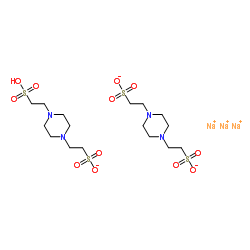PIPES

PIPES structure
|
Common Name | PIPES | ||
|---|---|---|---|---|
| CAS Number | 5625-37-6 | Molecular Weight | 670.682 | |
| Density | 1.5±0.1 g/cm3 | Boiling Point | N/A | |
| Molecular Formula | C16H33N4Na3O12S4 | Melting Point | >300 °C(lit.) | |
| MSDS | Chinese USA | Flash Point | N/A | |
|
Effect of (2)H and (18)O water isotopes in kinesin-1 gliding assay.
PeerJ 2 , e284, (2014) We show for the first time the effects of heavy-hydrogen water ((2)H2O) and heavy-oxygen water (H2 (18)O) on the gliding speed of microtubules on kinesin-1 coated surfaces. Increased fractions of isotopic waters used in the motility solution decreased the gli... |
|
|
Evidence that TSC2 acts as a transcription factor and binds to and represses the promoter of Epiregulin.
Nucleic Acids Res. 42(10) , 6243-55, (2014) The TSC2 gene, mutated in patients with tuberous sclerosis complex (TSC), encodes a 200 kDa protein TSC2 (tuberin). The importance of TSC2 in the regulation of cell growth and proliferation is irrefutable. TSC2 in complex with TSC1 negatively regulates the mT... |
|
|
Cell-free expression and in meso crystallisation of an integral membrane kinase for structure determination.
Cell. Mol. Life Sci. 71(24) , 4895-910, (2014) Membrane proteins are key elements in cell physiology and drug targeting, but getting a high-resolution structure by crystallographic means is still enormously challenging. Novel strategies are in big demand to facilitate the structure determination process t... |
|
|
Unique Features of Human Protein Arginine Methyltransferase 9 (PRMT9) and Its Substrate RNA Splicing Factor SF3B2.
J. Biol. Chem. 290 , 16723-43, (2015) Human protein arginine methyltransferase (PRMT) 9 symmetrically dimethylates arginine residues on splicing factor SF3B2 (SAP145) and has been functionally linked to the regulation of alternative splicing of pre-mRNA. Site-directed mutagenesis studies on this ... |
|
|
Identification and characterization of a cell division-regulating kinase AKB1 (associated kinase of Trypanosoma brucei 14-3-3) through proteomics study of the Tb14-3-3 binding proteins.
J. Biochem. 158 , 49-60, (2015) We used a proteomics approach to identify the binding partners of Trypanosoma brucei 14-3-3 (Tb14-3-3) which led to the identification of a novel kinase, AKB1. The binding between these two proteins was mediated by an amphipathic groove structure in Tb14-3-3 ... |
|
|
Polarized endosome dynamics by spindle asymmetry during asymmetric cell division.
Nature 528 , 280-5, (2015) During asymmetric division, fate determinants at the cell cortex segregate unequally into the two daughter cells. It has recently been shown that Sara (Smad anchor for receptor activation) signalling endosomes in the cytoplasm also segregate asymmetrically du... |
|
|
Inhibition of TRPM7 channels reduces degranulation and release of cytokines in rat bone marrow-derived mast cells.
Int. J. Mol. Sci. 15(7) , 11817-31, (2014) mast cells play an important role in airway inflammation in asthma. The transient receptor potential melastatin-like 7 (TRPM7) channel is expressed in primary human lung mast cells and plays a critical role for cell survival. This study aimed to investigate t... |
|
|
Yeast Coq9 controls deamination of coenzyme Q intermediates that derive from para-aminobenzoic acid.
Biochim. Biophys. Acta 1851 , 1227-39, (2015) Coq9 is a polypeptide subunit in a mitochondrial multi-subunit complex, termed the CoQ-synthome, required for biosynthesis of coenzyme Q (ubiquinone or Q). Deletion of COQ9 results in dissociation of the CoQ-synthome, but over-expression of Coq8 putative kina... |
|
|
Chemokine-mediated B cell trafficking during early rabbit GALT development.
J. Immunol. 193(12) , 5951-9, (2014) Microbial and host cell interactions stimulate rabbit B cells to diversify the primary Ab repertoire in GALT. B cells at the base of appendix follicles begin proliferating and diversifying their V-(D)-J genes around 1 wk of age, ∼5 d after B cells first begin... |
|
|
Phosphate modulates receptor sulfotyrosine recognition by the chemokine monocyte chemoattractant protein-1 (MCP-1/CCL2).
Org. Biomol. Chem. 13(7) , 2162-9, (2015) Tyrosine sulfation is a widespread post-translational modification that mediates the interactions of secreted and membrane-associated proteins in such varied biological processes as peptide hormone action, adhesion, blood coagulation, complement activation an... |